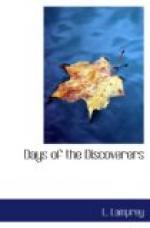“Hardly. This is fresh water. It’s the mouth of a river."[3]
“Yes, but might there be an isthmus—or the like?”
“A big river with as strong a current as this would not rise on a narrow, level strip of land, son. It’s bringing down tons of sand to make these banks we run into. There’s a great wide country inland there.”
The chanteys of the sailors were heard at daybreak in the lonely sea, as the Half Moon went on her way northward. On September 3 the little ship edged into another and bigger bay to the north. Whether it was a bay or a lake Hudson was at first rather doubtful. The shores were inhabited, for little plumes of smoke arose everywhere, and soon from all sides log canoes came paddling toward the ship. These Indians were evidently not unused to trading, for they brought green tobacco, hemp, corn and furs to sell, and some of them knew a few words of French. By this, and by signs, they gave Hudson to understand that three rivers, or inlets, came into this island-encircled sea, the largest being toward the north. Hudson determined to follow this north river and see where it led.
As he sailed cautiously into the channel, taking soundings and observing the shores, he was puzzled. The tide rose and fell as if this were an inlet of the sea, and it was far deeper than an ordinary river. In fact it was more like a Norwegian fiord.[4] It might possibly lead to a lake, and this lake might have an outlet to the western ocean. That it was a strait he did not believe. Even in the English Channel the meeting tides of the North Sea and the Atlantic made rough water, and the Half Moon was drifting as easily as if she were slipping down stream. In any event, nothing else had been found, either north or south of this point, which could possibly be a strait, and Hudson meant to discover exactly what this was before he set sail for Amsterdam.
They passed an Indian village in the woods to the right, and according to the Indians who had come on board the place was called Sapokanican,[5] and was famous for the making of wampum or shell beads. A brook of clear sweet water flowed close by. Presently Hudson anchored and sent five men ashore in a boat to explore the right-hand bank of the channel. Night came on, and it began to rain, but the boat had not returned. Hudson slept but little. In the morning the missing men appeared with a tale of disaster. After about two leagues’ travel they had come to a bay full of islands. Here they had been attacked by two canoes carrying twenty-six Indians, and their arrows had killed John Colman and wounded two other men. It grew so dark when the rain began that they dared not seek the ship, and the current was so strong that their grapnel would not hold, so that they had had to row all night.
Sailing only in the day time and anchoring at night the little Dutch ship went on to the north, looking between the steep rocky banks like a boat carved out of a walnut-shell, in the wooden jaws of a nutcracker. After dark, fires twinkled upon the heights, and the lapping waters about the quiet keel were all shining with broken stars. The flame appeared and vanished like a signal, and John Hudson wondered if the Indians knew John Smith’s trick of sending a message as far as a beacon light could be seen.




